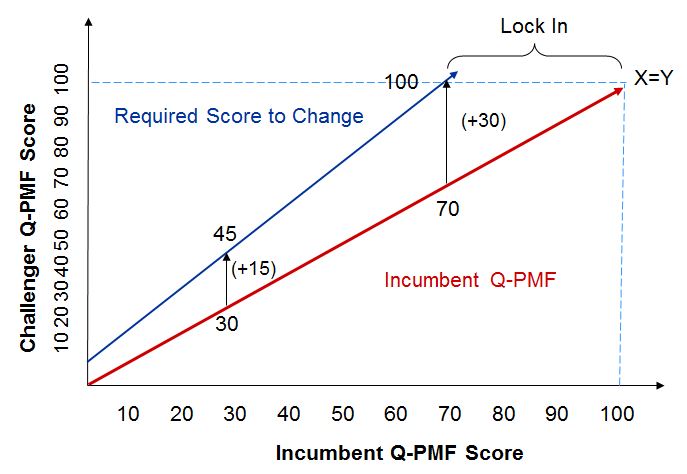Lock Out is Out.
In the bad old days, and still in some environments, Lock Out was an important business strategy. By Lock Out we mean any tactic that prevents competitors from offering their products to your customers. You might lock them out by controlling distribution, or access to a key raw material, or by leveraging power in one market to control another.
But in the Age of Hyper-Innovation, Lock Out strategies are harder to execute. Geographic, market, cultural, and product category boundaries are falling or becoming fuzzy. If someone else has a product that your customers like better, it is going to be hard to keep the customers from finding and buying it.
Lock In is In.
Lock In, however, is as powerful a force as ever. To understand Lock In, it is important to understand the concept of Switching Cost. In many product categories, switching from one product to another is not a friction-free process for the customer. And the more happy customers are with a product, the harder it is to get them to switch.
For example, if I’m not very happy with my broadband provider, maybe because the bandwidth is poor or the reliability is low, it won’t take much to get me to switch to someone else. If a competitor comes along with a product that’s just a little cheaper, or a bit higher quality, I might switch. But if I am very happy with my current product, a competitor product is going to have to be a LOT better. That is, the more I like a product, the harder it is going to be to get me to switch to a competitor.
It is this dynamic that makes lock-in possible. If a product has a high enough Q-PMF, it can be mathematically impossible for a competitor to take away its customers. Here’s how this works:

In this diagram, the blue line shows how much better a competitor would have to be in order to take customers away from an incumbent product whose Q-PMF is represented by the red line. If the incumbent has a Q-PMF of 30%, a competitor would need a Q-PMF of 45% or higher in order to offer enough value to customers to get them to switch. But if the incumbent has a Q-PMF score of 70%, the competitor has to be 30% better to get people to switch. The competitor would have to be perfect, with a Q-PMF of 100%.
And as you can see, if the incumbent has a Q-PMF over 70%, then it is not possible for a competitor to overcome switching costs no matter how good the product is. The product would have to have a Q-PMF of over 100%, which is not possible!
With a Q-PMF score of 71%, the incumbent has locked-in customers, effectively locking out the competition. The only way a competitor can crack this barrier is to change the value model – which is how most disruptive innovation happens as we saw in The Five Moves in the Innovator’s Playbook. Achieving Lock-In is the goal of every first-mover innovator and also of fast-followers; in a new or disrupted market, whoever can achieve lock-in first has a huge advantage (until the next disruption comes along!).
That’s It For Now…
For now, this is the end of our “Beta” draft of The Innovator’s Secret Formula. Thanks for taking a look, and if you have any thoughts or ideas please let us know by leaving a comment.
Having dropped down into this section, I was momentarily confused by the lack of a “next” button. If this is a detail page (or something akin to a deep side-bar), then some layout hint might be nice.
Great point. Added a “That’s it for now…” section to clarify.
Now, having used the ‘next’ buttons for the past couple of pages, I’ve arrived here in the order that I think you expected. Now that I am here, and I see that it is the last page in the pull-down navigation at the top of the page, I’m feeling a little like the book ended abruptly. There’s a really fun momentum that built up through the Innovator’s Toolkit section and I am craving and ending and denouement.
“If a product has a high enough Q-PMF, it can be mathematically impossible for a competitor to take away its customers.” – how did you arrive at the math of this? The basis is the Blue line is not clear. Eg at 30% qPMF, competition needs to be 50% better 0. Why 50%, and why not, say 20%?
Thank you for this comment! The basis of the blue line is switiching cost. That is, how much better does a new product have to be to get people to switch from what they are already using? The theory here is that if a new product would have to be 20% better to get people to switch, but the incumbent already provides 90% of the potential value, then the incumbent has achieved lock-in. No new product, no matter how good, can motivate people to switch.
Now of course that last statement is not purely true, because sometimes new products alter the value model in a way that truly disrupts the incumbents. See “The Three Modes of Product-Market Fit Change” for more on that.